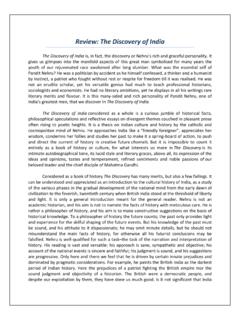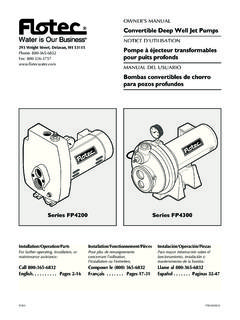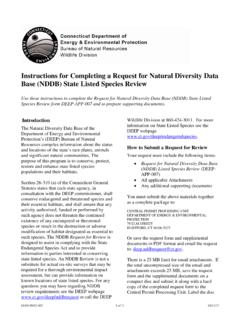Transcription of Policy on Incentives for Self-Policing - Connecticut
1 Effective October 23, 1996, revised March 27, 2000, with clerical edits July 12, 2004. Policy ON Incentives FOR Self-Policing . This Policy is designed to effect greater compliance with laws and regulations that protect human health and the environment by encouraging regulated entities to voluntarily discover, disclose, correct and prevent violations of environmental requirements through the use of environmental audits. The Policy provides three basic Incentives for companies to conduct such activities: (1). under the terms of an administrative consent order, full or partial waiver of penalties for violations discovered; (2) no recommendations for civil action or criminal prosecution; and (3). no routine requests for environmental audits. The Department will apply the Policy to regulated entities in Connecticut . The Policy applies equally to programs delegated to the State by EPA and those regulated solely by State authority. This is a discretionary Policy document.
2 Its applicability to a given circumstance rests with the discretion of the Commissioner of Environmental Protection or his designee. The policies and procedures in this document are intended solely for the preliminary guidance of employees of the Department. They are not intended to, nor do they, constitute rulemaking for the agency, and they may not be relied upon to create a right or a benefit, substantive or procedural, enforceable at law or in equity, by any person. The Department may take an action that is at variance with the policies or procedures contained in this document if the Commissioner considers it appropriate in a specific case. A. Definitions For purposes of this Policy , the following definitions apply: Environmental Audit has the definition given to it in EPA's 1986 audit Policy on environmental auditing, , a systematic, documented, periodic and objective review by regulated entities of facility operations and practices related to meeting environmental requirements.
3 Due Diligence encompasses the regulated entity's systematic efforts, appropriate to the size and nature of its business, to prevent, detect and correct violations through all of the following: a) Compliance policies, standards and procedures that identify how employees and agents are to meet the requirements of laws, regulations, permits and other sources of authority for environmental requirements;. Policy on Incentives for Self-Policing page 2 of 6. b) Assignment of overall responsibility for overseeing compliance with policies, standards, and procedures, and assignment of specific responsibility for assuring compliance at each facility or operation;. c) Mechanisms for systematically assuring that compliance policies, standards and procedures are being carried out, including monitoring and auditing systems reasonably designed to detect and correct violations, periodic evaluation of the overall performance of the compliance management system, and a means for employees or agents to report violations of environmental requirements without fear of retaliation.
4 D) Efforts to communicate effectively the regulated entity's standards and procedures to all employees and other agents;. e) Appropriate Incentives to managers and employees to perform in accordance with the compliance policies, standards and procedures, including consistent enforcement through appropriate disciplinary mechanisms; and f) Procedures for the prompt and appropriate correction of any violations, and any necessary modifications to the regulated entity's program to prevent future violations. Environmental audit report means the analysis, conclusions, and recommendations resulting from an environmental audit, but does not include data obtained in, or testimonial evidence concerning, the environmental audit. Gravity-based penalties are that portion of a penalty over and above the economic benefit., , the punitive portion of the penalty, rather than that portion representing a defendant's economic gain from non-compliance. Regulated entity means any entity, including a federal, state or municipal agency or facility, regulated under federal or state environmental laws.
5 B. Incentives for Self-Policing . 1) No Gravity-Based Penalties: Where the regulated entity establishes that it satisfies all of the conditions of Section C of the Policy , the Department will not seek gravity-based penalties for violations of environmental requirements. 2) Reduction of Gravity-Based Penalties by 75%: the Department will reduce gravity-based penalties for violations of environmental requirements by 75% so long as the regulated entity satisfies all of the conditions of Section C (2) through C (9) below. 3) No Civil or Criminal Referrals: Policy on Incentives for Self-Policing page 3 of 6. (a) The Department will use administrative consent orders to effectuate the purposes of this Policy . Provided the regulated entity is in compliance with the terms of the consent order, the Department will not refer the regulated entity to the Office of the Attorney General, the Office of the Chief State's Attorney or other prosecuting authority where the Department determines that all of the conditions in Section C are satisfied, so long as the violation does not demonstrate or involve: i) a prevalent management philosophy or practice that concealed or condoned environmental violations; or ii) high-level corporate officials' or managers' conscious involvement in, or willful blindness to, the violations.
6 (b) Whether or not the Department refers the regulated entity for criminal prosecution under this section, the Department reserves the right to recommend prosecution for the criminal acts of individual managers or employees. 4) No Routine Request for Audits: the Department will not request or use an environmental audit report to initiate a civil or criminal enforcement action of the entity. C. Conditions 1) Systematic Discovery: The violation was discovered through: a) an environmental audit; or b) an objective documented, systematic procedure or practice reflecting the regulated entity's due diligence in preventing, detecting, and correcting violations. The regulated entity must provide accurate and complete documentation to the Department as to how it exercises due diligence to prevent, detect and correct violations according to the criteria for due diligence outlined in Section A. The Department may require as a condition of penalty mitigation that a description of the regulated entity's due diligence efforts be made publicly available.
7 2) Voluntary Discovery: The violation was identified voluntarily, and not through a legally mandated monitoring, sampling or reporting requirement prescribed by statute, regulation, permit, judicial or administrative order, or consent agreement. For example, the Policy does not apply to: a) emissions violations detected through a continuous emissions monitor (or alternative monitor established in a permit) where any such monitoring is required;. b) violations of National Pollutant Discharge Elimination System (NPDES) discharge limits detected through required sampling or monitoring: c) violations discovered through a compliance audit required to be performed by the Policy on Incentives for Self-Policing page 4 of 6. terms of an administrative or court order or settlement agreement. 3) Prompt Disclosure: The regulated entity fully discloses a specific violation within 30 days (or such shorter period provided by law) after it has discovered that the violation has occurred, or may have occurred, in writing to the Department.
8 4) Discovery and Disclosure Independent of Government or Third Party Plaintiff: The violation must also be identified and disclosed by the regulated entity prior to: a) the commencement of a federal, state or local agency inspection or investigation, or the issuance by such agency of an information request to the regulated entity;. b) notice of a citizen suit;. c) the filing of a complaint by a third party;. d) the reporting of the violation to the Department (or other government agency) by a whistleblower employee, rather than by one authorized to speak on behalf of the regulated entity; or e) imminent discovery of the violation by a regulatory agency;. 5) Correction and Remediation: The regulated entity corrects the violation within 60 days, certifies in writing that violations have been corrected, and takes appropriate measures as determined by the Department to remedy any environmental or human harm due to the violation. If more than 60 days will be needed to correct the violation(s), the regulated entity must so notify the Department in writing before the 60-day period has passed.
9 Where appropriate, the Department may require that to satisfy conditions 5 and 6, a regulated entity enter into a publicly available written agreement, administrative consent order or judicial consent decree, particularly where compliance or remedial measures are complex or a lengthy schedule for attaining and maintaining compliance or remediating harm is required;. 6) Prevent Recurrence: The regulated entity agrees in writing to take steps to prevent a recurrence of the violation, which may include improvements to its environmental auditing or due diligence efforts;. 7) Repeat Violations: The specific violation (or closely related or similar violation) has not occurred previously within the past three years at the same facility, or is not part of a pattern of federal, state or local violations by the facility's parent organization (if any), which have occurred within the past five years. For the purposes of this section, a violation is: a) any violation of federal, state or local environmental law identified in a judicial or administrative order, consent agreement or order, complaint, notice of violation or Policy on Incentives for Self-Policing page 5 of 6.
10 Otherwise documented by the Department, EPA or other governmental agency, a conviction or plea agreement; or b) any act or omission for which the regulated entity has previously received penalty mitigation from EPA or the Department or local agency. 8) Other Violations Excluded: The violation is not one which (i) resulted in serious actual harm, or may have presented an imminent and substantial endangerment to human health or the environment, or (ii) violates the specific terms of any judicial or administrative order, or consent agreement. 9) Cooperation: The regulated entity cooperates as requested by the Department and provides such information as is necessary and requested by the Department to determine applicability of this Policy . Cooperation includes, at a minimum, providing all requested documents and access to employees and assistance in investigating the violation, any noncompliance problems related to the disclosure, and any environmental consequences related to the violations.
















